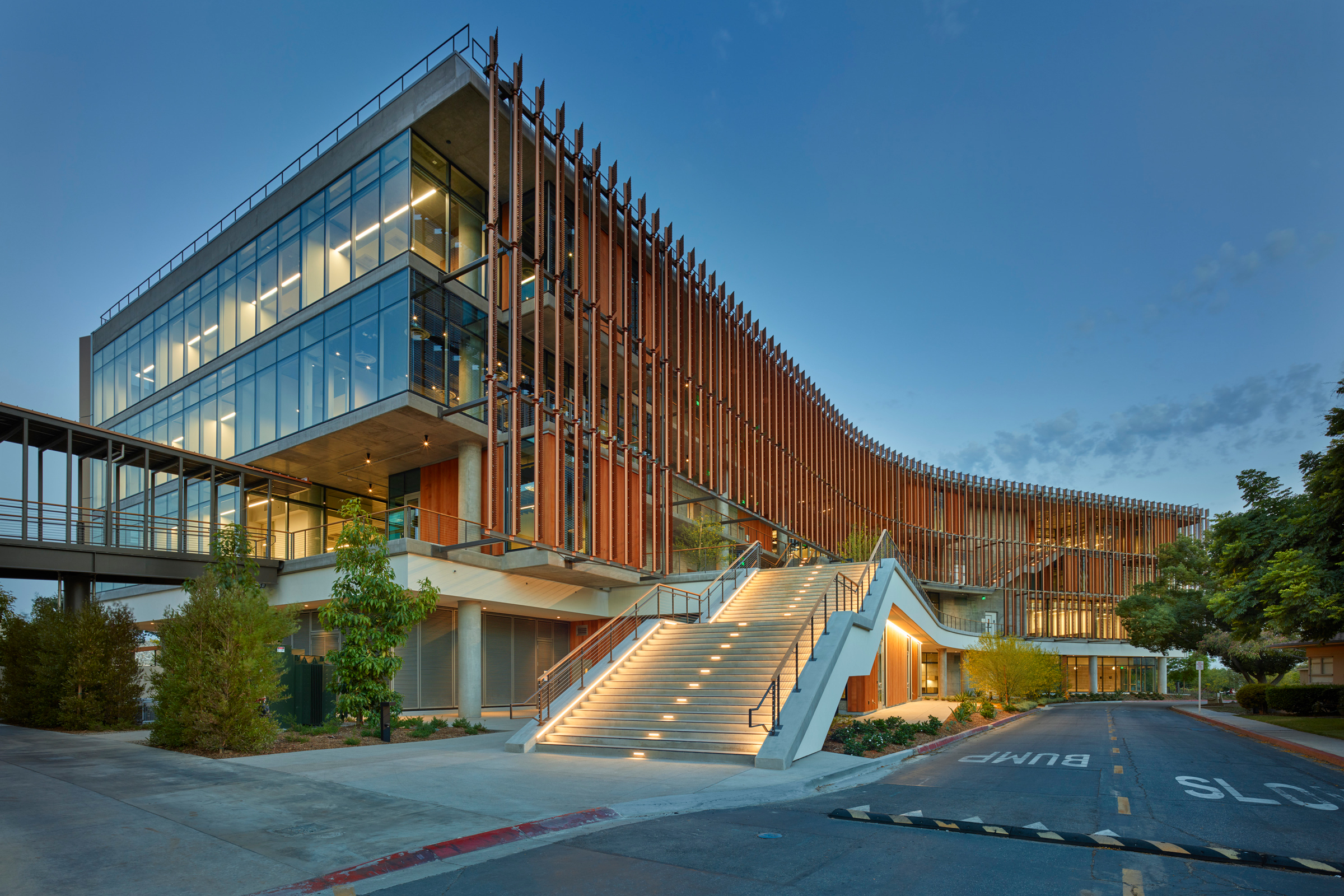Story at a glance:
- The demand for LEED buildings is increasing, according to the US Green Building Adoption Index.
- These 15 LEED projects range from education centers and homes to nature centers and office buildings.
- Universities like Yale have committed to achieve carbon neutrality by or before 2050.
LEED-certified buildings are on the rise and making our cities greener, according to the 2019 US Green Building Adoption Index by CBRE.
“The 2019 Green Building Adoption Index shows that 4,879 or 13.8% of all commercial office buildings across the 30 largest U.S. office markets are green certified—the highest total in the index’s history. Measured in square footage, 42.2% of total space across the top 30 office markets is green certified, up from 41.9% last year,” CBRE said.
Architects and designers hoping to achieve LEED certification can look to a variety of projects for inspiration. As the need for LEED-certified building projects increases, it’s important to consider the surrounding built environment.
“LEED is the most widely used green building rating system in the world. Available for virtually all building types, LEED provides a framework for healthy, highly efficient, and cost-saving green buildings. LEED certification is a globally recognized symbol of sustainability achievement and leadership,” according to the USGBC.
From earning points for using sustainable wood and Energy Star appliances to improving projects with solar panels and natural lighting, a variety of design strategies can help architects earn LEED in both commercial and residential projects. These are just a few projects offering inspiration.
1. Botanical Research Institute of Texas Headquarters, Fort Worth
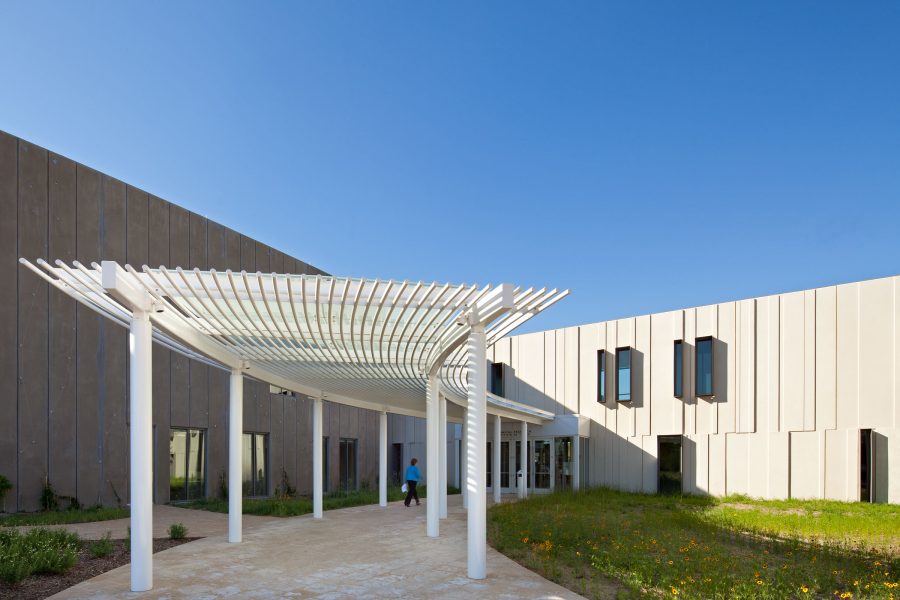
The Corgan-designed Botanical Research Institute of Texas (BRIT) project includes both structural and aesthetic concrete components. Photo by Chris Cooper
Designed by H3 Hardy Collaboration Architecture in partnership with Corgan, the Botanical Research Institute of Texas (BRIT) headquarters is one of Texas’ earliest LEED Platinum certified buildings.
The project spans a total of 70,000 square feet across two interconnected structures: the so-called “Think Block,” which houses administration offices, research labs, education and exhibit areas, and public spaces, and the “Archive Block,” home to the group’s herbarium and library. A framework of stainless steel guide wires adorn the Archive Block’s exterior, facilitating the growth of vining plants that serve as an outward manifestation of what takes place inside.
Precast concrete was used extensively throughout the project for both structural and aesthetic purposes—a decision driven by cost considerations and construction efficiency, as well as other factors like the reduced waste associated with pre-manufactured materials and precast concrete’s thermal insulating capabilities.
“The concrete becomes both your envelope and your structure, meaning you don’t have duplicative columns or foundations,” Matt McDonald, commercial sector leader and principal at Corgan, previously told gb&d.
A geothermal field underneath the parking lot and rooftop photovoltaic panels allows the facility to produce a large portion of its own energy, while windows and a large glass facade greatly reduce artificial lighting requirements in the Think Block. To help conserve water—an important practice in drought-prone Fort Worth—the building makes use of low-flow fixtures and harvests rainwater for its irrigation needs.
As one might expect from a botanical research institute, extreme care was exercised when considering all on-site landscaping and plantings. Many of the site’s existing trees, for example, were retained, while indigenous species were prioritized to help create biodiverse habitats for native fauna—as evidenced by an extensive swath of restored Fort Worth prairie biome located behind the BRIT building.
Other notable features include an expansive green roof—complete with native soil blend mixed specifically for BRIT and seeded with native species—that helps provide passive cooling, bioswales to help mitigate stormwater runoff, a retention pool, and an outdoor classroom boasting garden plots and a geology wall.
2. Nashville International Airport Concourse D, Nashville
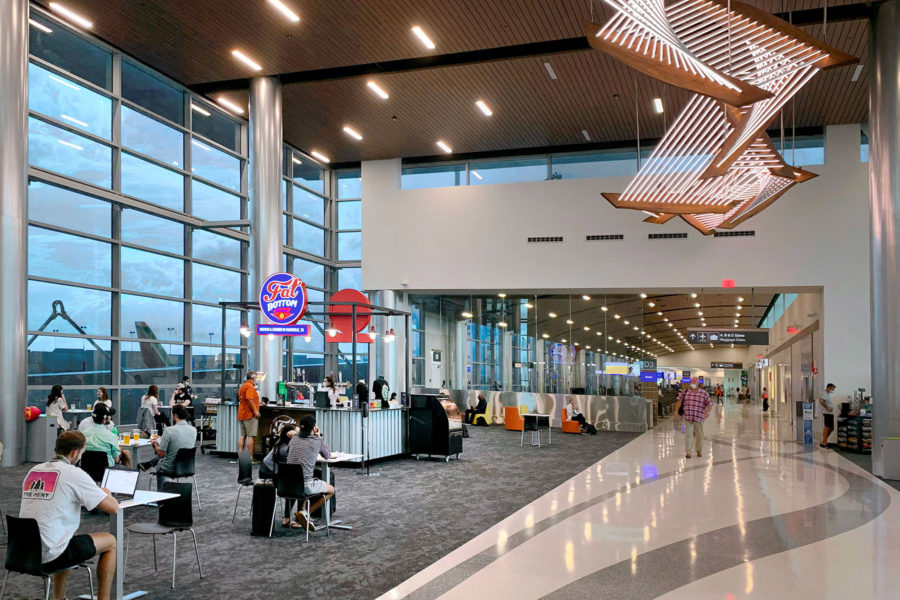
An innovative, passenger-centric design and construction approach deems the Nashville International Airport’s new Concourse D one of only five LEED v4 Silver airport facilities in the US. Photo courtesy of Fentress Architects
Designed by Fentress Architects and Corgan to LEED Silver standards, Nashville International Airport’s (BNA) Concourse D was one of nine newly constructed airport facilities in the world to achieve LEED v4 certification at the time of its completion in 2020.
Concourse D was conceptualized from the ground up with sustainability in mind and features a bevy of green, wellness-focused features.
“At every stage of the project, from the design process to construction, the project team remained committed to aligning our approach with the airport’s sustainability targets,” Deborah Lucking, director of sustainability at Fentress Architects, previously told gb&d.
Energy efficiency was a top priority for the new concourse. Fentress delivered in this department by way of a programmable lighting system that dims in accordance with natural daylight levels. Switchable electrochromic glass was also installed to help prevent glare and unwanted solar heat gain, reducing cooling loads and making for a more comfortable interior environment.
The facility also boasts a geothermal cooling system, water-conserving plumbing, and makes strategic use of light-colored paving and building materials to help reflect solar energy and combat the urban heat island effect.
“LEED certification is a coveted mark of environmental distinction and innovation,” Doug Kreulen, president and CEO of BNA, told gb&d in a previous article. “We’re building not only a bigger airport, but also a better, ‘greener,’ more sustainable airport. I’m proud of our commitment to these principles and appreciative of all the hard work that went into obtaining this recognition.”
In addition to its many green building strategies, Concourse D also employs inclusive design tactics to ensure both convenience and usability for all visitors. This is best exemplified by the project’s inclusive spaces, of which include a mother’s room, indoor service animal relief area, and family restrooms.
3. La Conner Swinomish Library, La Conner, WA
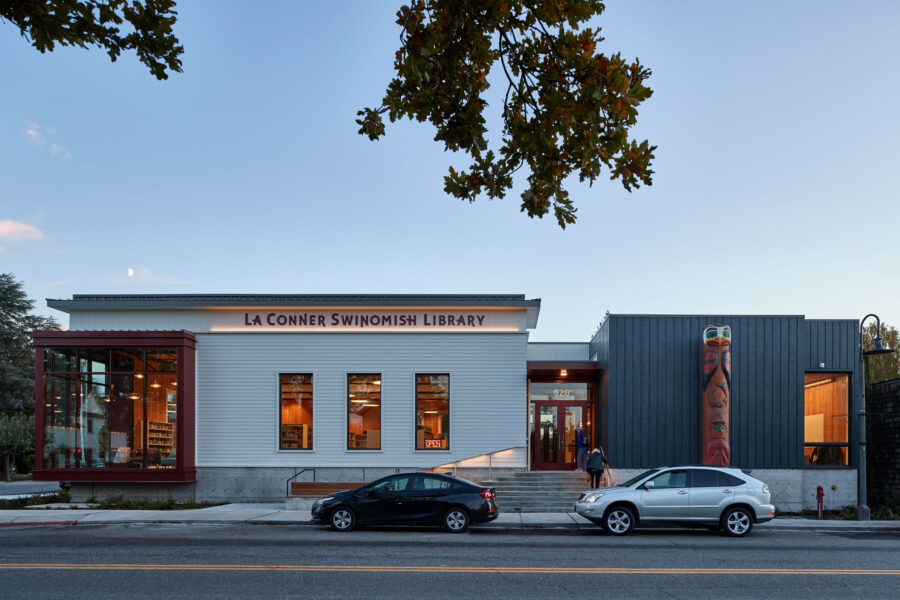
An 18-foot tall cedar story pole was hand-carved with traditional iconography from Coast Salish culture for the front of the La Conner Swinomish Public Library. Photo by Doug Scott
When the small maritime town of La Conner, Washington decided to upgrade its 1,500-square-foot one-room library, the neighboring Swinomish Indian Tribal Community became one of the project’s largest benefactors. This partnership is reflected in the completed La Conner Swinomish Public Library—designed by the BuildingWork architect team—whose LEED Silver design honors elements of both Coast Salish culture and the town’s historic past.
The first thing patrons see when they arrive at the new library is the 18-foot tall cedar story pole standing outside the front entrance. Designed by Kevin Paul, a Swinomish elder and master carver, the story pole depicts a traditional Salish person with outstretched hands at its base, two salmon to represent sustenance and resources, and an eagle at its peak to represent wisdom.
When it comes to the building itself the library is constructed almost entirely from locally-sourced cross laminated timber, a low-carbon engineered wood product with a high compression strength similar to that of concrete. Wood cladding and detailing, along with decorative cornices and vertically proportioned windows, helps the building emulate the style of La Conner’s historic 1800s-era architecture.
“We’re proud of how it came out from a design standpoint,” Matt Aalfs, founder and principal architect of BuildingWork, told gb&d in a previous article. “It was a wonderful opportunity to figure out how the architecture could reflect native culture in a really authentic way and present a public space that is welcoming to everyone.”
The library also makes extensive use of daylighting strategies; a massive corner bay window brings in natural sunlight from the east while tall vertical windows and skylights allow diffuse daylight to penetrate deep into the building’s interior. A rooftop photovoltaic array helps reduce emissions associated with the scant artificial lighting that is required and slashes the building’s annual energy usage by an estimated 41%.
4. ASU’s Rob & Melani Walton Center for Planetary Health, Tempe, AZ
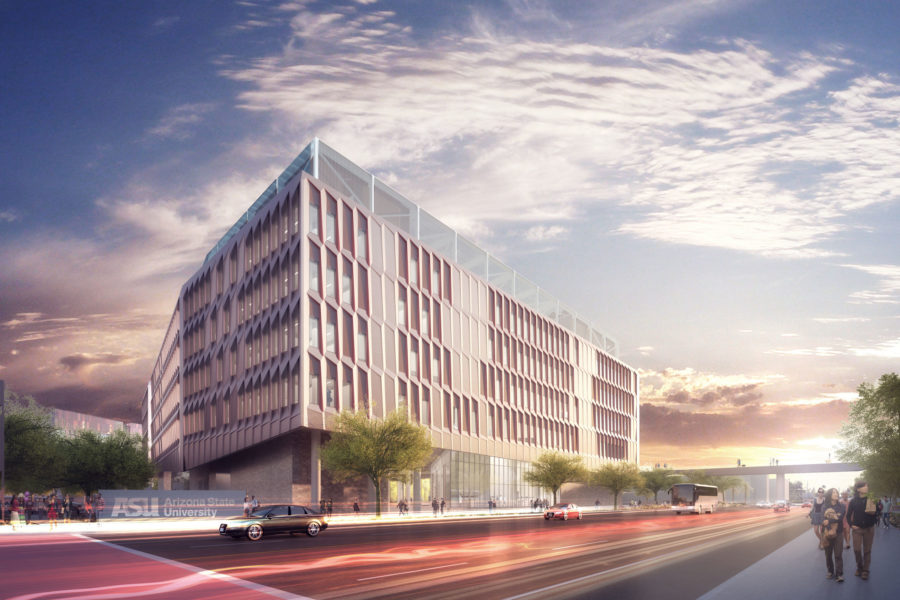
ASU’s Interdisciplinary Science & Technology building 7 (ISTB-7) achieved impressive sustainability goals with the help of GCP Applied Technologies and others. Rendering courtesy of Architekton | Grimshaw
Arizona State University (ASU)’s Rob & Melani Walton Center for Planetary Health isn’t the campus’ only LEED-certified building, but it is one of the most progressive thanks to its LEED Platinum status.
As with many big projects, the design team at ASU had the challenge of choosing material responsibly. With cement as a choice material, architects Architekton & Grimshaw, engineers Buro Happold, and McCarthy Building Companies wanted to find a way to use cement to offset the building’s embodied carbon.
The team set out to utilize a post-consumer byproduct to reduce the total amount of Portland cement in the building structure by at least 40%. In addition to the sustainability requirements, the concrete for this project needed to be aesthetically pleasing since it would be used in Class A architecturally exposed columns, walls, stairs, deck soffits, and polished concrete floors.
After much collaboration with McCarthy Building Companies and admixture supplier GCP Applied Technologies, Hanson Aggregates used fly ash alongside WRDA 64® water reducer with ADVA® 195 superplasticizer from GCP Applied Technologies. Once they selected a mix the team started batch trials to ensure it performed as structurally intended.
5. Miami Beach Convention Center, Miami Beach
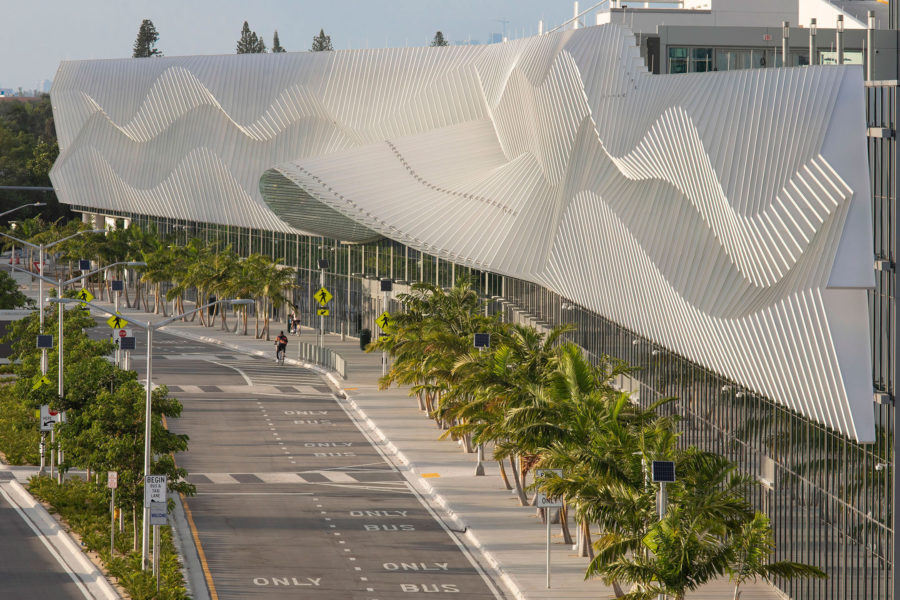
The context-driven design of the Miami Beach Convention Center reflects the natural elements of Miami’s acclaimed beaches, including waves, manta rays, and coral reefs. Photo by Robin Hill
The redesigned Miami Beach Convention Center (MBCC) is a top-tier example of a community event space committed to sustainability. The project achieved LEED Silver certification from the USGBC in 2020.
The MBCC’s design was part of the City of Miami Beach’s vision to reposition the center as one of the most technologically advanced convention centers in the US. One of the main focuses of the project was to stay up-to-date with FEMA code as part of a resiliency plan to safeguard against future hurricanes and flooding.
Fentress Architects collaborated with Arquitectonica on the context-driven design to incorporate natural elements. Part of this process included the design team adding 12 acres of greenspace, preserving more than 100 existing trees, and adding more than 1,300 new trees. As a result the design increases the previous acreage of the 25-acre campus by 245% and significantly reduces heat island effect.
6. Yale Science Center, New Haven, CT
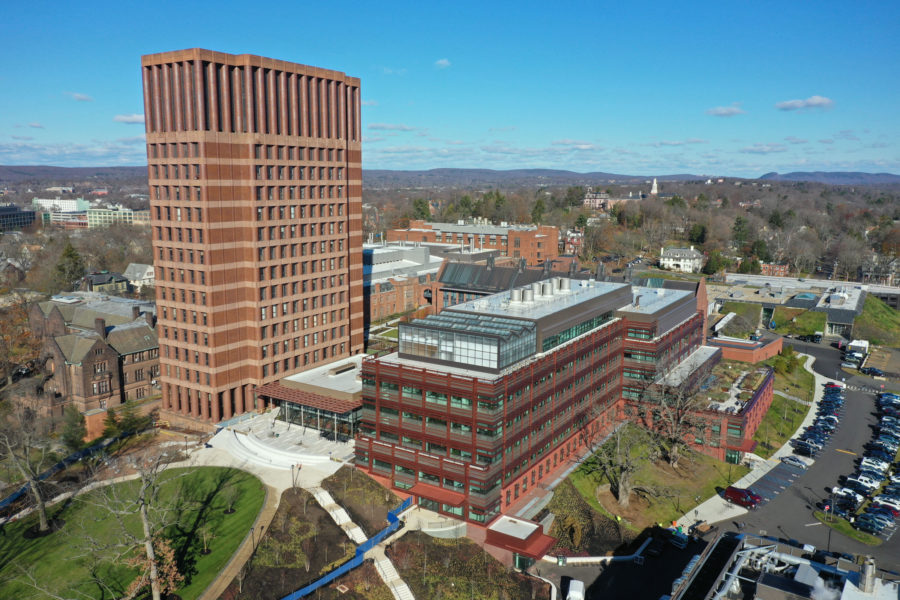
The Yale Science Building features high-performance air distribution and heat recovery. Photo by Paul Coco
In 2010 Yale University began requiring that all renovations and new buildings meet LEED Gold. This university-wide plan showcases the potential for not just one LEED-certified project within a built ecosystem, but many, with consideration for renovations and rebuilds.
The Yale Science Building opened in 2019 with an energy use intensity target of 200 KBTU—half of what comparable lab spaces on-campus consume. The Yale Science Building was designed to meet LEED Gold, with features like high performance air distribution, heat recovery, and lighting systems. The project also has a rooftop greenhouse.
Yale is committed to ensuring its infrastructure is good for the environment as well as the student body.
“IAQ is crucial to the health and well-being of building occupants. Our standards ensure the use of materials with low VOCs, nontoxic materials, healthy furniture, and appropriate air changes and filtration,” Ginger Chapman, director of the office of sustainability at Yale, previously told gb&d.
7. Administrative Office Building, Duarte, CA

Photo by Benny Chan, Fotoworks
Walter P Moore completed an administrative office building for The City of Hope in the spring of 2020. City of Hope in Duarte, California is a comprehensive cancer center focusing on advancing research and treatment protocols.
Walter P Moore provided structural and enclosure engineering for the project as well as a Whole Building Life Cycle Assessment, contributing to a structure that has been designated LEED Gold v4. The design firm said, “We found that importing superior aggregate from British Columbia and using supplemental cementitious materials to replace a portion of the Portland Cement the team was able to maintain construction schedule but reduce the embodied carbon of the structure by over 2.8 million pounds of CO2e.”
LEED-certified projects like this office building will ensure high performance as well as thoughtful features like exterior walkways, cascading stairs, less insulation, solar panels, and a steel/mesh sunshade.
8. AstraZeneca West Coast Center, San Francisco
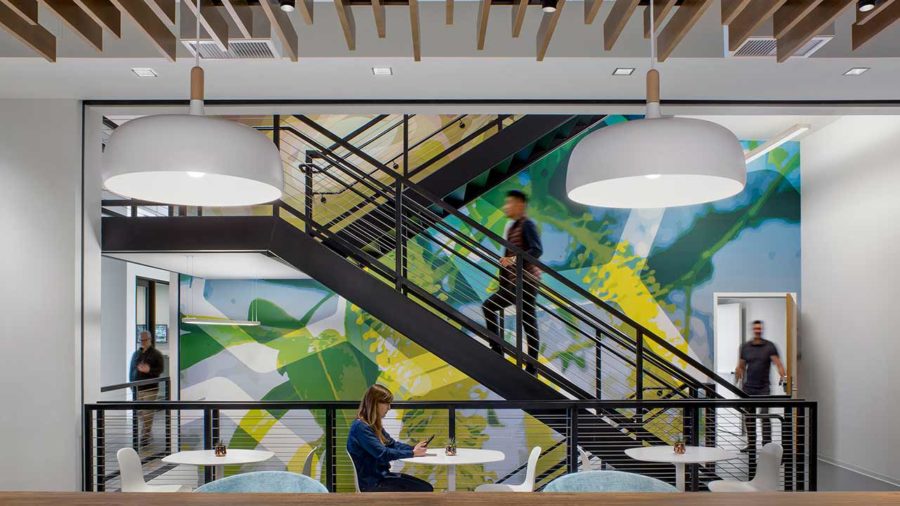
AstraZeneca and HOK put a focus on the way people will inhabit the West Coast Center. Photo by David Wakely
HOK designed AstraZeneca’s 100,000-square-foot West Coast Center to consolidate four divisions of the company into a single facility. The project features energy-efficient, LEED Platinum–certified interiors that prioritize employee connectedness and comfort, with an added emphasis on daylighting. A majority of the work spaces offer ample natural lighting.
In terms of energy reduction, the design cut out unnecessary lab equipment, improved the core and shell, and reduced the site’s mechanical system capacity. The team paid great attention to the center’s plug load as well, Erin Ezell, an HOK senior sustainable design specialist, previously told gb&d.
All of the research refrigeration equipment was replaced with the highest efficiency models available, and all lights run on occupancy and daylight controls. The project also features daylight harvesting systems, and automated shades are installed around the perimeter. The project was further elevated by adding water efficiency systems, locally sourced materials, and centralizing freezers into an efficient farm.
AstraZeneca aims to be energy-, carbon-, and water-neutral by 2025, and this project brings the company one step closer to that goal.
9. Environmental Nature Center & Preschool, Newport Beach, CA

The new 8,000-square-foot, three-classroom Environmental Nature Center (ENC) Preschool is the second LEED Platinum Net Zero building on ENC’s 4.7-acre campus in Newport Beach. Photo by Cris Costea Photography
LPA Design Studios’ work on The Environmental Nature Center and Preschool (ENC) in Newport Beach included conserving energy and water to support the center’s mission of sustainability. At the time it was recognized as the first LEED Platinum building in the region.
The ENC has been operating net positive since 2008, generating 60% more energy than it’s using. The preschool was expected to be net positive, generating 105% of the preschool’s power needs. No natural gas was used in the building, and PV panels supply 100% of the ENC’s power.
Additional features include photovoltaic panels that are designed to provide 105% of the net energy for the preschool’s electrical needs. Single-sloped roofs capture the water, which is channeled through rock basins to bioswales, where the water is naturally treated and clarified by plant materials before leaving the site to recharge aquifers. All of the plants across the campus are native to California and do not require irrigation.
10. Engineering Innovation Hub, New Paltz, NY

The Engineering Innovation Hub at State University of New York in New Paltz will accommodate programming and support collaboration between the college and local industry. Photo by Leon Hordijk, Surfacedesign
State New York University at New Paltz opened its Engineering Innovation Hub (EIH) in 2019 and achieved LEED Gold status. The EIH was designed by Urbahn Architects, who worked with engineering and construction teams to achieve LEED Gold on a limited budget.
LEED points were awarded for a variety of features throughout the project. The building’s roof is a white reflective TPO (thermoplastic polyolefin) membrane system, with added insulation to improve the R-value. This composition reduces the heat island effect by providing a high solar reflectance index.
The design of a 31,200-square-foot landscaped site contributes to the project’s sustainability. The project team addressed the LEED category of Sustainable Sites and Water Efficiency in several ways. The entire building site was formerly covered by a parking lot, and the new site plan maximized the open green area surrounding the building footprint. The final building envelope and mechanical systems designs resulted in an energy cost savings of 28%. The building is also close to public transportation and provides bike storage.
11. Sierra Nevada Brewing Co., Mills River, NC
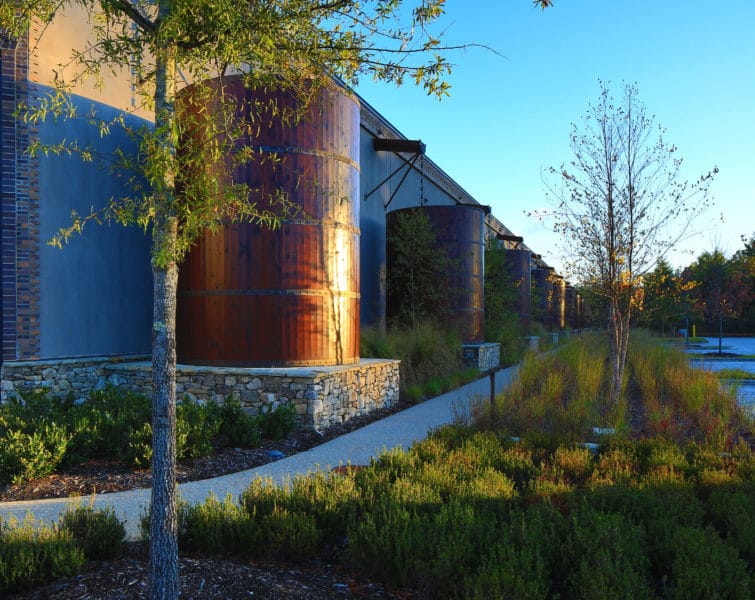
Photo courtesy of Sierra Nevada Brewing Co.
Designed by Russell Gallaway Associates to meet LEED Platinum standards, Sierra Nevada’s Mills River facility in North Carolina—which acts as a sister location to the company’s first brewery in Chico, California—perfectly encapsulates the company’s commitment to green brewing.
“Sustainability was integrated into every facet of the construction project, from materials selection to construction waste management,” Cheri Chastain, sustainability manager at Sierra Nevada, previously told gb&d.
Completed in 2016 the Mills River brewery encompasses 312,260 square feet and sits amidst the trees in a highly forested area of Mills River. As a testament to Sierra Nevada’s conservation efforts, natural resource specialists were hired to improve the health of the surrounding forest, while all of the timber cleared to make room for the brewery itself was reclaimed and used in the taproom’s construction. Sierra Nevada was able to divert 81% of the facility’s construction waste from landfills.
Rainwater is also collected and stored on-site in a 500,000-plus gallon cistern, where it is then used for landscape irrigation and flushing toilets—which in turn reserves a higher percentage of potable water for brewing purposes. An onsite wastewater treatment plant further aids in water conservation and even helps generate biogas energy via an anaerobic digester and microturbine technology.
In addition to biogas energy, the Mills River facility also produces green energy via photovoltaic solar panels. Overall, the brewery uses almost 50% less energy than traditional breweries and renewable energy accounts for approximately 32% of the facility’s energy use.
12. Wellesley Residence, Wellesley, MA
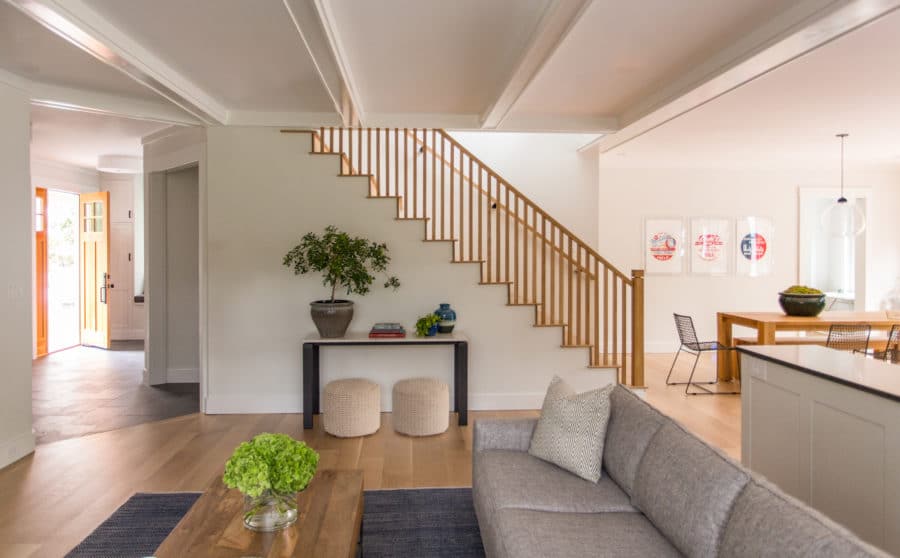
This LEED home in Wellesley, MA features continuous insulation, an airtight envelope, and triple-pane high-performance windows. Photo by Eric Roth
Residential architects are also using LEED to prove the sustainability of their projects, like ZeroEnergy Design’s (ZED) recent New England home. The 4,200-square-foot house is not only comfortable and convenient, it’s also LEED Platinum.
Some of the features that earned the project valuable LEED points include durable materials, finishes, cabinetry, and casework throughout the house that have low or no VOCs. The team also designed a mechanical system with ventilation to provide constant fresh outdoor air.
The house also offers an impressive solar array that faces the backyard. The project incorporates many of the top building enclosure strategies—continuous insulation, an airtight envelope, and triple-pane high-performance windows—combined with an efficient HVAC system. Other efficient systems within the house include an air source heat pump for heating and cooling, a heat pump hot water heater, LED lighting, energy recovery ventilation.
13. The Powerhouse, Beloit, WI

The Powerhouse facility in Beloit, Wisconsin, has a running track, conference facility, batting cages, café, and more. Photo by Tom Harris
The Powerhouse—a LEED Silver–certified student union and recreational center at Beloit College—was a unique reuse design opportunity for Studio Gang. The prestigious team of architects embraced one of their core philosophies by starting a design with what’s already there with this project. For the Powerhouse, that meant reinventing a 120,000-square-foot decommissioned power plant.
Juliane Wolf, partner and design principal at Studio Gang, worked with Beloit President Scott Bierman and Beloit’s vision to transform the former power plant into a human-use building for students and the community. Beloit College worked with Alliant Energy to ensure the building was not torn down, which ended up being a huge benefit in the building’s carbon emission performance.
One of The Powerhouse’s most impressive sustainable resources is the nearby Rock River, which helps supply a portion of the building’s energy. “The building is cooled and heated with a river-source geothermal system,” Dan Schooff, chief of staff at Beloit College, previously told gb&d. “The Rock River helps power the electric heat pumps, which reduces our use of fossil fuels. We use this system to cool and heat the building, mostly through radiant panels and radiant floor slabs.”
14. McDonald’s Chicago Flagship, Chicago
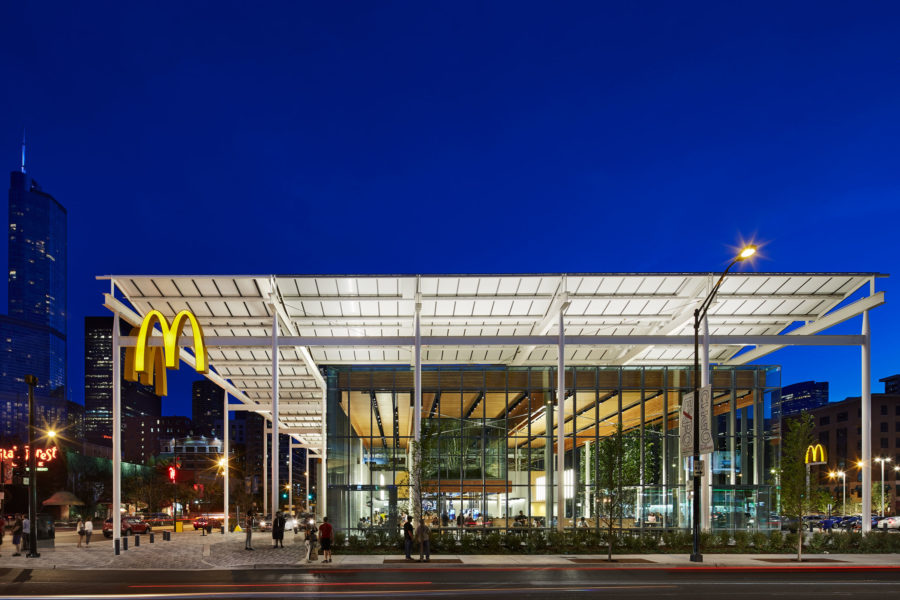
McDonald’s flagship restaurant in Chicago was designed by Ross Barney Architects. Photo by Kendall McCaugherty, Hall+Merrick Photographers
Designed by Ross Barney Architects and spanning an entire city block, the McDonald’s Chicago Flagship is an incredibly sustainable building that looks to celebrate the simplicity and enduring authenticity of one of the world’s most iconic restaurant chains.
Featuring a cross-laminated timber (CLT) structural system as well as glulam structural elements, the building has a much lighter environmental footprint than similar structures built with concrete and steel. Indeed, the carbon sequestered and saved by this CLT is equivalent to removing more than 34,000 passenger vehicles from the road for one year.
Aside from its liberal use of mass timber, the project boasts a slew of other sustainable features that helped it earn LEED Platinum certification, including solar panels, permeable pavement, interior plants, daylighting, and—perhaps most impressively—a series of green roofs.
“The green roofs are planted with harvestable trees and native plants. The rooftop orchard contains Honeycrisp and Gala apple trees ranging from 8 to 9 feet tall as well as edible plants, including arugula, broccoli, and carrots—all living within the orchard’s canopy,” Carol Ross Barney, founder and design principal of Ross Barney Architects, wrote in a previous gb&d article. “This food from the rooftop is harvested each fall.”
A second rooftop garden planted with white birch trees and ferns is contained within a floating glass terrarium inside and above the dining room, further increasing the restaurant’s green space per square footage. “Green space is expanded by more than 400%, producing a new park-like amenity for a dense area of Chicago,” writes Ross Barney. “Surrounding the restaurant is a park with an outdoor dining space and permeable pavement, topped with a solar pergola to provide shade and feed energy back into the building and to the grid.” Consisting of 1,062 solar panels, this pergola generates roughly 60% of the building’s annual electrical energy.
15. Montgomery Middle School, Chula Vista, CA
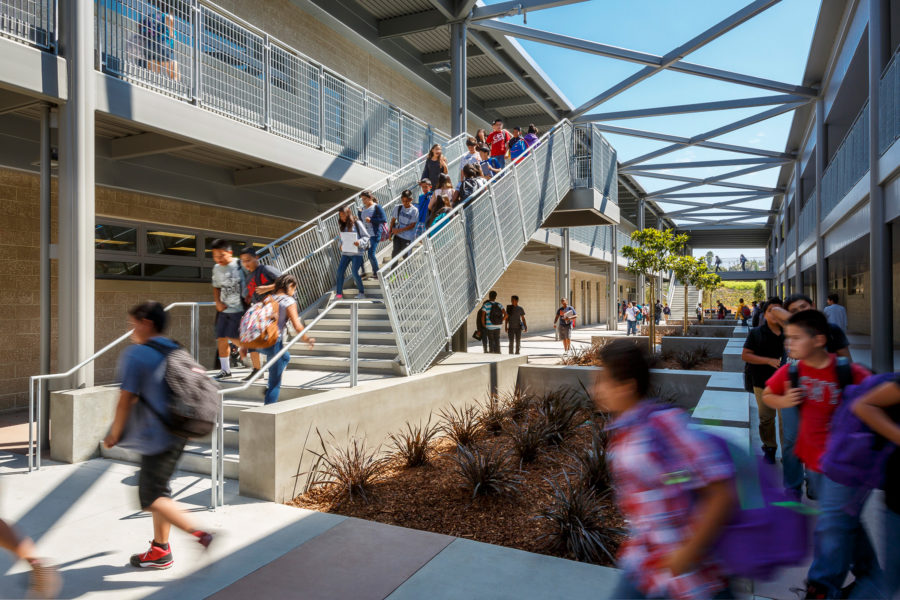
Montgomery Middle School. Photo courtesy of LPA Design Studio
In 2013 LPA worked with Sweetwater Union High School District in California to develop a net zero design for a 37,500-square-foot addition for Montgomery Middle School. The expansive project earned LEED Platinum certification.
The school is built on an east-west axis to maximize daylighting, minimize heat gain and allow for natural ventilation. LPA was sure to include an innovative HVAC system installed in an outdoor mechanical yard. This feature freed up space for photovoltaic arrays, while a bioswale filters and releases storm water into the ground, so water damage will never again plague the school. These design strategies help offset 100% of the facility’s reduced energy use.
New schools like Montgomery Middle School can be catalysts for positive change in their communities and they will serve multiple generations while maintaining net-zero.
Jessica Powers contributed to this article.

